| 18th century archaic head |
|---|

A granite carving of a human head, mounted on the south gable of the shed. This apotropaic (averting evil) carving has an extremely atavistic quality, with its appearance of a severed head it is powerfully reminiscent of Celtic Iron Age works relating to the cult of the head. Indeed if found buried in the peat bog one might think it was such. However it is presumed to date from the origin of the building to which it is attached. This is one of the oldest structures in the village one can clearly see where corrugated iron has replaced thatch, some aspects of the shed suggest it may have originally been a dwelling. It is situated near what would originally have been a major crossroad pre-dating the village square crossroad to the south and the Fraserburgh-Banff turnpike junction a mile to the north. Possibly this structure was part of the hamlet of Cyaak that preceded the village. The house on whose feu it stands No 48 High St is itself nearly as old as the foundation of the village in 1787 and was once a butchers, at which time the shed may have been used for slaughtering. More Information |
A
| Aberchirder wells |
|---|

Solid granite built, pill box like well housings in the village of Aberchirder which like many 18th century planned villages is better known by the name of the farm toon that preceded it, in this case Foggieloan Moss from two Gaelic words foidh (peat moss) and lon (meadow), so Foggieloan means peaty or boggy meadow. More Information |
| Abercrombie Coat of Arms |

Category B, Abercrombie coat of arms, St Mary's churchyard inset into exterior wall More Information |
| Anderson marriage datestone |

A restored and gilded marriage datestone for John Anderson and Helen Ogilvie dated 1699 above a religious text. More Information |
| Archway with Mask Detail |
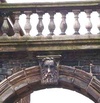
Listed Category A. Italianante building by Thomas Mackenzie, Elgin 1851-4 , with unusual queen-head capitals and Corinthian pilastered triparte with shell motif over centre light. Linked at south by tall round headed archway incorporating carved bearded head. The interior has 1st floor hall which takes up the entire frontage, the ceiling being supported by 6 pairs of draped female figures clasping laurel wreaths. The Town Hall was originally built as the St. Andrew's Lodge of Masons Hall. More Information |
| Art-deco Shops |

Possibly Colonel Tawse and Messrs Hall, 1936. Single storey and 2-storey with attic, 6-bay, terraced, Art Deco style former Co-operative building adjoining separately listed Carron Restaurant, Cameron Street. Fine decoratively-astragalled top-lights, coloured glass medallions and original shop doors with brass door furniture. Granite ashlar shop fronts, with crenellated, crowstepped darker ashlar 1st floor bays; harl and coursed rubble to side. Oversized stylised keystone and capitals. |
B
| Bairds of Auchmedden, Recumbent Figure Tomb |
|---|

A fine recumbent figure tomb set in a gabled enclosure, the Medieval meets the Renaissance in a particularly Scots idiom. There is an interesting central motif below the figure of corn springing from bones. The wild boar in the crest is extremely rotund and has something almost oriental in its design. Inscriptions: (motto at top) Dominus fecit. (main plaque) An. Dom. 1636. Positum a Georgio Baird de Aucbmedden praeposito Burgi de Bamff in honors Dei & in memorii praedicessoru quorum corpora in die resurrectionis . hic sepulta jacent.(underneath with memento mori) G. B. Mors sceptra ligonibus aequans. Spes altera vitae. Coelum non solvm quaero. More Information |
| Banchory-Ternan Watchtower in Kirkyard |
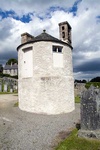
A circular white harled 2 story tower. Conical slated roof with round finial, a lum (for a fire to keep watchers warm) and bellcote (for bell to raise the alarm). Recently restored by the Banchory Rotarians. The warning bell is dated 1664 and probably came from an early church on the site, established as a missionary base by St Ternan around 490AD. More Information |
| Banff Castle and Banff Castle Gates |

The new Banff Castle mansion, was built by Lord Deskford in 1749-52 the architect was John Adam, stands on the grounds of the original fortified castle. The Oglvies of Findlater and Deskford held Banff Castle and the ruins of the old remained beside the new for 70 years until demolished in 1820. All that now remains of the medieval Castle are the northern and eastern curtain walls, ditch and rampart, and the postern. The pavilion roofed mansion has flanking two-storey pavilions, and a 19th century porch. |
| Banff Museum and Library Interior |
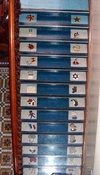
Two pictures of the staircase, lino cuts produced by the children at Banff Academy in the 1950's in association with the linoleum company each image representing a letter of the alphabet. More Information |
| Biggar Fountain |
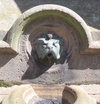
Ornate Victorian Gothic drinking fountain with crown head, designed by John Rhind in 1878, commemorates Walter Biggar, one of the founders of the herring trade with the Baltic. The inscription on the Biggar fountain reads 'Presented to the town of Banff in Memory of Walter Biggar Esq. And Mrs. Anne Duff, his wife. 1878.' Biblical inscriptions on the East and West panels. I think the spouts are intended to represent fish heads, possibly dolphin fish? More Information |
| Bodie Fountain |
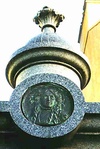
Category C listed. |
| Boyndie Kirk bellcote |
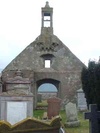
Category C listed, Scheduled monument . 17th century gable with ball capped bellcote, the sole remains of the kirk. Contains 58 table top stones of which 9 are significantly decorated and over 100 upright stones from the early 19th - 20th century. A high proportion of these stones are decorated with symbols of mortality, immortality and trade emblems. More Information |
C
| Cairness House |
|---|

Cairness House is considered one of the finest examples |
| Carved Marriage Datestone |
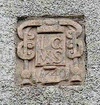
Listed Category B. Boyndie House 1740, an unusual house with a delicately shaped Dutch-gable, with two round eyes below the chimneys, and carved marriage stone as a shaped cartouche bearing the initials IG MS. Marriage stones appear to have been particularly popular in Banff. It was customary for the sons and daughters of town worthies to have an initialled datestone built into their houses in honour of their union. More Information |
| Carved Stones, Fetternear House |

Photo 1:Carved sandstone, fragmented, set in the front of Fetternear House which was destroyed by fire in 1919. |
| Christians house Doorway Arch |
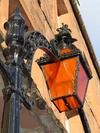
An ornate decorative cast iron arch supporting a large lantern of orange-red glass, which presumably was once illuminated by an oil or gas lamp. |
| Clunie Street School Bellcote |
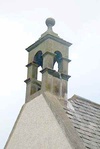
Former school, dated 1804 with ball- finialled apex bellcote which crowns the gable of the building. Datestone bears the inscription 'FREE SCHOOL Endowed by Alexander Pirie,1805'. More Information |
| Cowie Chapel, St. Marys of the Storms, Cowie Kirkyard |

The old kirk now stands as a consolidated ruin, originally dedicated to St. Nechtan, or St. Nathlan, though it was rededicated to St. Mary in 1276. It was never a parish kirk and was suppressed by the kirk session in the 1560s. |
| Culblean Memorial |

A modern stone menhir with bronze plaque commemorating a 14th century battle. More Information |
| Cupola, Weather Vane, etc |

Extravagant Neo-Jacobean, tall gabled hospital with timber arcaded cupola with faceted lead roof and weathervane, 1860. Alexander Chalmers of Clunie (Marnoch, Banffshire) wine Merchant and ship owner in Banff left 'the site of his residence' and a bequest of £70,000 to build and endow the hospital. More Information |
D
| Delgatie Castle |
|---|

Delgatie Castle dates from about 1030. The main tower dates from the 1100s while its final extension with the battlement walk above the string course was completed in 1579. Both wings were added in 1743. |
| Delgatie Doocot |

An unusual pink harled circular structure with three tiers of decreasing diameter. A circular dovecot in good repair: three sharply diminishing stages with batten, rubble-built. Entrance with chamfer and relieving arch, widened at lower courses. 708 stone nesting boxes. Similar to those at Auchry and Huntly but appears to be considerably older. More Information |
| Domed Well Housing |

Listed category A. Domed peristyle Well in Forecourt accompanied by Garden of Remembrance. The new Banff Castle, built by Lord Deskford in 1750, stands on the grounds of the original fortified castle. More Information |
| Duff House Pediment |
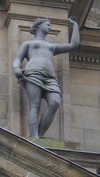
Substantial Baroque mansion 3 story on raised basement fluted Corinthian pilasters to tower heads, pediment to principal floor. The South (principal) elevation has the pedimented centre piece with exuberant armorial carving Duff Arms and Motto. The original lead statues are preserved in the house and have been replaced by fibre glass copies which stand above the pediment, representing Mars, Apollo and Minerva. On the north elevation Bacchus, Mercury and Diana. |
| Duff House, the Fife Gates |

Pair of polished ashlar octagonal gate piers with moulded stepped caps supporting fine carved stone urns. Decorated with acanthus and swags of fruit and flowers. Gates probably made by the Banff Foundry (James Fraser) a firm which provided similar to other local country house estates, including Castle Fraser. House open to the public. See their website for details. More Information |
| DUFF HOUSE, BANFF, BRIDGE STREET, BRIDGE OF BANFF LODGE |
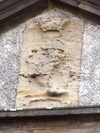
A small classical pedimented pavilion with Venetian windows (now blocked and painted with false panes). A solitary survivor of a pair that guarded the eastern entrance of the Duff House policies. It has been relocated and truncated and is now used as an electricity sub-station and the basement for supermarket trolleys. |
| Dunnideer, tower house and vitrified hill fort remains |

A dramatic hilltop ruin with stunning views over the surrounding countryside. More Information |
| Dunnottar Cemetery Stonehaven, general info |
|
There have been a number of churches on the present site. The original church, dedicated to St. Bridget in 1394, was replaced in 1593 by the 5th Earl Marischal (George Keith), which in turn was replaced in 1782 by a much larger church. The church was completely reconstructed in 1903 and remodelled into a cruciform plan by G.P.K. Young of Perth, with parts of the 1782 church incorporated into the present building. The kirk is of a rectangular plan built of granite rubble with Gothic details. There is a plain ball-capped bellcote on the E. gable. |
E
| Early Crosses, Banchory |
|---|

A relic of St Ternan's Monastery still remaining at Banchory is a slab with two incised Celtic crosses, built into the Tilquilly vault in the chuchyard. Discovered by J W Robertson, Aberdeen. |
F
| Façade, Trinity and Alvah Church |
|---|

Listed category C. Designed by Robert Raeburn of Edinburgh in the Ionian mode of that city, with portico and cupola. Enlarged in 1876, fortunately the façade was left intact, it has a most unusual beamed roof inside. More Information |
| Fanlight |

Listed category B. |
| Features at Dunnottar Castle |

The castle; probably occupies the site of a prehistoric fort. St Ninian established a church here about the beginning of the 5thC. It may also be the -Dunfoithir- besieged in 681. In the reign of William the Lion (1165-1214) -Dunnottar- was the place where warrants were returnable for the Mearns, and -le castiel de Dunostre- is mentioned at the beginning of the 13thC. Another castle was erected at the end of the 14thC. In its final form the castle was forfeited in 1716 and the roofs and floors removed and sold. In 1925 the systematic repair and excavation of the ruins was begun.In its present form the extensive remains date from various periods. The oldest portion is the early 15thC keep with a range of buildings extending to the E containing stables & storehouses. The gatehouse is approached by a steep path and defended by three tiers of splayed gun-loops. The arched entrance is the only opening on a solid wall of masonry set into a cleft in the rock; a very impressive and dominating entrance. The buildings to the NW grouped round a courtyard date from the late 16th or early 17thC, including a chapel. A huge water system lies within the courtyard. There is also a bowling green to the W of this later range. The Scottish Crown jewels (The Honours of Scotland) were hidden here in 1651 as it was considered one of the strongest places in the kingdom. In 1685 167 Covenanters were packed into a small vault, (the Whigs Vault) where 9 died due to the terrible conditions. Privately owned (Dunecht Estates) and open to the public. An oval motte was noted in 1970. More Information |
| Features at Tolquhon castle |

Apart from the original Preston tower this is not a building with serious defensive intent, more a stylish country palace. As with the tomb for the same client and the other castles he was involved in the design of, Leper has combined what was then modern style with older traditions to create a fusion that is peculiarly Scottish. He has an approach that resonates with C. R. Mackintosh in a much later era. More Information |
| Fettercairn Mercat Cross |
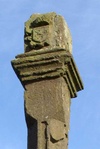
Fettercairn will have had some kind of market cross since 1504 when the status of a free burgh of barony was first granted. It is is said by some that the shaft of the current cross originally stood in the burgh of Kincardine which declined and eventually ceased when the judicial headquarters of the county moved to Stonehaven in 1600. There is no historical record of the cross being moved in this manner. |
| Fyvie Cross |
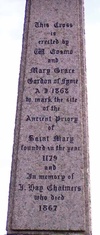
Corrennie granite Cross (erected 1868) and cairn – all |
| Fyvie stone carved relief figure holding head |
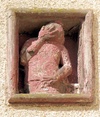
Stone carved figure covering face with hand, the other hand appears to be cradling the head of an infant at waist height. Interpretation is slightly speculative as the stone is quite badly eroded. More Information |
G
| Gibbet Stone |
|---|
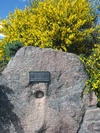
A large asymetrical stone with a socket and plaque. More Information |
| Grave Slab of Gilbert de Greenlaw |

Sandstone, the upright slab to Gilbert de Greenlaw, who was slain at the battle of Harlaw in 1411, stands in the kirk and exhibits a finely incised figure of a knight. The stone was obviously broken and reused, by a Forbes in 1592, with a Forbes incised armorial crest of three dogs and dated 1592 on the reverse side also inscribed with latin and greek texts. |
| Grotesque Human Mask, Date Stone |
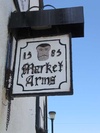
Category B listed building. The Market Inn is dated 1585 on a painted lunette stone with grotesque moustachioed head - you can see it by going through the pend arch. The building in it's present form could be as late as 18th century but incorporating earlier fabric, but it is certainly the oldest building in continuous occupation in Banff. More Information |
| Grotesque Lion Mask, Lintel Decoration |

Category B listed building. Incorporated in this symmetrical fronted building, centre corniced door with shoulder lintel with carved grotesque head and heavily quoined jambs, there is hint of Adam Senior influence in the doorpiece. More Information |
H
| House with Decorative Datestone and Angle Mural sundial |
|---|
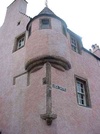
Category A listed building. Interesting and unusual survival of an early town house, the angle turret is a very rare feature, this distinguished dwelling also has a polygonal stair to the rear. The corbel stone bears the date 1675 and is decorated with two leaves. The building also incorporates an angle mural sundial. The building was restored by Banff Preservation Society circa 1970 and is now privately owned. More Information |
I
| Innes plaque, Banff |
|---|

A small carved stone armorial plaque embellished with gilding. Plaque dated 1780. The plaque pre-dates the building it is affixed to. It shows the monogram JJ, the motto, of the Innes family,"ORNATUR RADIX FRONDE, The root is adorned by the foliage" with the palm frond crest of the Innes family. I believe the plaque may relate to John Innes, 8th of Edingight, Provost of Banff (b 22.02.1721, d 07.06.1790). More Information |
| Interior of Banff town hall, Coffered Ceiling Supported by 6 Pairs of Female Figures Clasping Laurel Leaf |

Listed Category A. Italianante building by Thomas Mackenzie, Elgin 1851-4 , with unusual queen-head capitals and Corinthian pilastered triparte with shell motif over centre light. Linked at south by tall round headed archway incorporating carved bearded head. The interior has 1st floor hall which takes up the entire frontage, the ceiling being supported by 6 pairs of draped female figures clasping laurel wreaths. The Town Hall was originally built as the St. Andrew's Lodge of Masons Hall. More Information |
K
| Kinkell Kirk, Calvary Panel, replica |
|---|
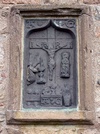
Bronze metal panel built into the north wall of Kinkell Church, showing the crucifixion, a figure of the Virgin Mary and an Angel. |
L
| Lion Fountain, Drum |
|---|

A stone carving of a lion crouched to spring in the middle of a large circular pool. More Information |
M
| Macduff Parish Church or Doune Church |
|---|

Incorporating 3 story domed tower, in 1865 the church was re-modelled and the original steeple replaced by a Italliante square tower with lead domed roof and cupola into which was installed the town clock. More Information |
| Macduff, Burgh or Market Cross |

Category B listed granite cross incorporating small carved plaque at apex, inscribed narrow slabs as arms mounted on square tooled granite plinth. Carving on apex depicts a figure on horseback and bears the arms of the Earl of Fife. Dated 1783 but incorporating earlier fragments. The cross bears the inscription, on 2 panels one on either side: Macduff Cross. Rebuilt at Macduff by the Earl of Fife, 1783 when the town was constituted a Royal Burgh by George III. May it flourish, increase in number and opulence, ----- while it's inhabitants gain the blessing of life by industry, diligence and temperance." The words on the inscription are taken to refer to the fact that a stone was taken from the ancient Macduff Cross in Fife and built into the Macduff one, to form some sort of symbolic connection between the ancient and modern bearers of the name Macduff. At the beginning of the last century it was popular for youths to light fires at the foot of the cross. As a result the cross fell and is now shorter. More Information |
| Marine Hotel carved heads |

(possibly 17th century, certainly older than the 1884 date of the building) carved heads thought to have originated at the nearby Dunnottar Castle, situated to the south of Stonehaven. Although badly weathered, the fine carving can still be seen on those of the human and lion heads. |
| Marine Hotel Shield Datestone |

A shield shaped datestone decorated with an anchor and 2 monograms More Information |
| Meethill monument - Reform tower Peterhead |
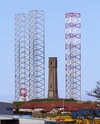
A tall tapering five storey tower, Greek cross in section, with a crenellated parapet corbelled out over the remainder. |
| Montcoffer doocot |

The dovecot at Mount Coffer House is cylinder-shaped. The walls are harled and rest on a plinth. A blocked up narrow slit recess, shaped as a cross at the top and a circle at the bottom, is present on the north and on the south side. The entrance is in the west side. Currently roofless probably late 18thC. More Information |
| Mormond Hill White Horse |

There are many different stories as to the origin of the horse. One is give below. The horse is constructed of quartz on Waughton Hill which is contiguous with Mormond hill (usually the whole prominence is referred to as Mormond). It is 162' long by 126' high. The horse was cleaned in 1937, 1949, 1968 and more recently in 1994. The hill is neither high nor steep but as the surrounding landscape is very flat, much of it peat bog, the hill and the horse are a significant presence in the landscape for some miles around. More Information |
| Mounthooly dovecot |

A tall dovecot with chamfered angles forming an octagonal plan. It is built of harl pointed rubble with tooled granite ashlar dressings and margins with heavy boulder footings. It is built in two stages with long elevations on the N, S, E and W with doorway in the west. There is an oval oculus in the E, W and S elevations above a continuous alighting ledge. The wallhead is slightly corbelled and crenallated wallhead with each merlon capped by ball finial (12 in number). The wallhead masks a pyramidal slate roof. Inside the interior is lined full-height with approximately 300 brick nesting boxes with the base of each box constructed of brick slabs. A tall potence ladder still survives although some of the rungs are missing. Dated 1800. It was built by Lord Garden of Gardenstown when he bought the Pitsligo Estate. Each ball finial is said to represent one for each of his 12 Estates. |
| Mural Sundial |

Angle mural sundial and date stone enscribed "George Massie, Elspet Morrison 1739 Gods Providence is ourInheritance." More Information |
| Myrus Cemetery Gates |
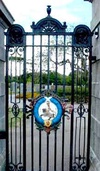
Highly ornate wrought iron cemetery gates, bearing winged angels and painted town emblem with rider on horseback, also featured on MacDuff Town Cross and Town Hall. More Information |
N
| North Sea first air crossing memorial |
|---|
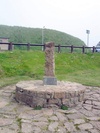
A small monolith of pink Peterhead granite set upright on a rotunda of masonry itself set on a pavement of irregular slabs all in rough Peterhead granite, a bronze plaque has this inscription "From the sands of Cruden Bay on the 30th July 1914 the Norwegian Aviator Kommander Tryggve Gran D.F.C made the first crossing of the North Sea by air." |
O
| Ogilvie tomb, St Marys kirkyard Banff |
|---|

A simple 16th century table top tomb for a hausband and wife. Inscription reads: ANO. DNI. 1558.29 NOVE. OBIIT. VALTERVS. OGILVY. DE. DVNLVGVS. MILES . PRAEPOSITVS . HVIVS . VRBIS . ET . HIC. JACET. CV. ALISONA. HVME. EIVS. SPOSA. OBIIT. 23. JVLII. ANO. 1557. More Information |
| Ogilvy Family Armorial Panels and Carvings |

Five carved 17th and early 18th century monogrammed pediments and armorial panels reset in the South return gable of the Royal Bank. The panels were removed from the house of Thomas Ogilvy which formerly occupied the site. The property later became the town house of the Baird of Auchmedden, later being demolished and reset into The National Commercial Bank (now Royal Bank) in 1937. The Royal Bank, 1937 by James McCallum, Architect and Master of works, Commercial Bank of Scotland. The panel in the fourth photograph has the Ogilvy motto "secundat vera fides" (true faith prospers). More Information |
| One of a Pair of Female Sphinxes on the Gate Piers |

Cairness House is an important work by James Playfair the gate piers and sphinxes were added to mark the centenary of its building. More Information |
P
| Plague Stones - Gravestones |
|---|
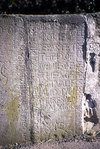
Near to plague burial-ground; plague or victims were interred not here but in a nearby hollow to the south east of Victoria Street, at a site known as The Maltman's How. The site is now occupied by modern buildings and gardens. Two gravestones were found about 1842 (which had lain on a what at that time was a piece of waste ground, they were then erected against a bank on the left of the path opposite the Bog Well ) and are now set into the E wall of a public footpath at NO 8741 8552. Stone to N dated 1608 with death's head and shield incorporating 'MT' monogram, reading 'Heir lyes ane honest man, Magnvs Tailiovr, seyman, qvha depairtit in November, (in the time of) pest 1608'. Stone to S dated 1648 and reading 'Heir lyes ane Honest mans bairns Alexander and William Brokie, sones lawful to Alexander Brokie, who departet the 12 of Jwnie, of the age of tvalf and nyn yeirs old, in ano 1648'. More Information |
| Plaque datestone on the Salmon House Portsoy |

A carved painted datestone with a relief carved cock salmon between figures 18 and 34 within plain raised border with angle fluted 'fan' motif. The salmon is somehow more 'cuddly' than most representations of this popular subject More Information |
| Possible Hindu Sculpture |

Built into house wall above entrance door on east side of street. A small stone carving showing two female and one male nude figures. This is a small sculpture about a foot across and set quite high up. The female figure on the left has suffered some unfortunate censorship (unintentional I hope) by cement render. |
Q
| Queens Head Capitals Detail |
|---|
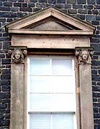
Listed Category A. Italianante building by Thomas Mackenzie, Elgin 1851-4 , with unusual queen-head capitals and Corinthian pilastered triparte with shell motif over centre light. Linked at south by tall round headed archway incorporating carved bearded head. The interior has 1st floor hall which takes up the entire frontage, the ceiling being supported by 6 pairs of draped female figures clasping laurel wreaths. The Town Hall was originally built as the St. Andrew's Lodge of Masons Hall. More Information |
R
| Radulfus Slab, St Drostans Church, Insch |
|---|

The two medieval burial monuments have been placed against the outer face of the WNW gable. The first, which measures 1.05m in height, is the head and torso of the effigy of a knight dating to the late 13th- or early 14th century. It is heavily weathered, and the figure's face has sheered off, but traces of detail survive along its more sheltered sides; the figure is clad in mail armour, with a coif, a surcoat, a belt, and a large shield. Beside the effigy there is a grave-slab of red sandstone measuring 1.8m in length by 50mm in thickness and tapering in breadth from 0.43m to 0.34m. At its wider end a wedge-armed cross has been incised within a circle. Running along the slab is an incised inscription reading: ORATE:PRO:ANIMA:RADULFI:SACERDOTIS:. |
| Reform Monument |

Monument; erected in 1833 , it was erected by local ‘Tories’ (Conservatives) on the site of the market cross to celebrate Parliamentary reform. A Roman Doric column surmounted by the arms of the Earl Marischal with a lion above; this coat of arms was originally in a gateway to Inverugie castle, recently restored. |
S
| Saint Drostans Well |
|---|
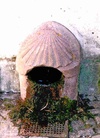
A Victorian pink granite basin and cover carved with a scallop shell motif, for a spring traditionally associated with the dark age St Drostan who is supposed to have landed on this beach before evangelising the Buchan area in Pictish times. More Information |
| Saunders Heritage Coat of Arms Armorial Plaque |

Category B listed building. Coat of Arms dated 1675, built into arched gateway. Plaque initialled IG IS to John Gordon and his wife Janet Saunders, incorporating coat of arms. The plot of ground was called Saunders Heritage. The plaque was reset above the archway at the East return gable of Banff's former Police station, later the Post Office. More Information |
| Shell Detail Seafield Street View |

Listed Category A. Italianante building by Thomas Mackenzie, Elgin 1851-4 , with unusual queen-head capitals and Corinthian pilastered triparte with shell motif over centre light. Linked at south by tall round headed archway incorporating carved bearded head. The interior has 1st floor hall which takes up the entire frontage, the ceiling being supported by 6 pairs of draped female figures clasping laurel wreaths. The Town Hall was originally built as the St. Andrew's Lodge of Masons Hall. More Information |
| Shoemakers Land Plaques |

Listed category B. Plaque above pend entrance inscribed '1716. Rebuilt by the incorporation of shoemakers 1787' motif of a leather workers crescent shaped knife surmounted by a crown. Small lower plaque reads 'Restored by Banff Preservation Society 1975. The plaques were restored and painted by the Society in 2000 More Information |
| South Colleonard House |
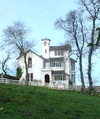
Privately owned and not accessible to the public. |
| St Colms Well Portsoy |
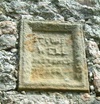
Rubble built tunnel type entrance, the well is said to have been built in the early part of the 7th century. The well 2ft diameter, and still flowing, is now covered by a stone cupola with an arched entrance. The well is hidden away in an earth mound (Perhaps a burial mound since it is adjacent to the cemetery) You can only see the well if you actually enter the cemetery by the gate at the bottom of the hill opposite the caravan for the warden of the caravan site. The plaque, made from the soft unstable yellow sandstone of the area, is just recognisable as St Colm's well but will be lost soon, the plaque dates from when the well was restored in 1893 though the date is now hardly readable. |
| St Drostans Church Insch Bellcot |
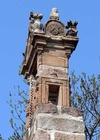
All that remains of the old kirk of Insch, said to be gifted to the Abbey of Lindores before 1195, is the W. gable complete with a stunning example of a 17th - century pedimented bellcote, in ornately carved red sandstone. The elaborate carving includes the letters M I L , The minister John Logie and the date 1613 |
| St Johns Kirk Gamrie |

The ruined church of St Johns; the ruins of former parish church dedicated to St John the Evangelist said to be founded in 11thC. The present church has been built in two periods at least, the east end probably early 16thC and the rest 17thC; measures 28.75m long by 4.72m wide; rubble built, gable ends; wall and gable remain to roof height; ambry in E wall; 16thC Barclay of Tolly monument; 17thC onwards monuments in churchyard; fell in to ruin mid 19thC when new parish church built in 1830. Repointed in 1961. |
| St Lesmos Church (new) |

Church; 19thC; built over the ruins of the little mansion of the Lairds of Braeloine. The west extension of the church incorporates an arch and to the north a small bell-tower from this 17th C building. Still in use as a church. To the south of it a small farmstead called Braeloine, consisting of three buildings, is depicted on the OS map of 1867 but not on the 1888 edition. More Information |
| St Meddans, Medieval Gravestone |

Gravestone in abandoned churchyard made of crude slab of grey granite |
| St. Ciaráns Kirk Stonehaven, general |

Scheduled Ancient Monument. |
| St. Marys kirkyard Banff, general background |
|
A fascinating surviving burial ground of medieval origin in the heart of a town. It exhibits an almost theatrical assemblage of memorial art. It is enclosed by low rubble wall with railings and containing late 16th century Banff aisle, burial enclosures and tombstones. See external link for a complete list of inscriptions. |
| St. Meddans, Sacramental Recess |
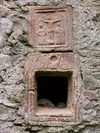
The sacramental recess for the communion cup in the ruin of St Meddans Church, Carved relief calvary in dark pink granite c. 15th century, showing the crucifixion with 2 Saints? More Information |
| Stonehaven Tolbooth Gates |

Heavy wrought iron gates in a grid pattern with protruding scrolls at top and bottom of the vertical bars. The building dates from the 1500s but I do not know if the gates are contemporary with it. More Information |
| Stuart Royal Arms, Banff |
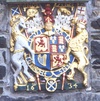
The Stuart Royal Arms built into wall adjacent to Banff's Town house steeple, situated at The Plainstones, res-et and painted. |
T
| Tank trap with world war II graffiti |
|---|

A square concrete block of the kind that once covered much of the coasts of Britain and Europe, with carved graffiti. Blocks of concrete such as this still stretch all the way from Aberdeen to the mouth of the River Ythan at Newburgh. There are also extant examples on more northerly Aberdeenshire beaches that could have been used for landing. Built in 1940 they were designed to prevent tanks landing during the feared Nazi invasion. Some have simple graffiti on them but this one was richly decorated by Louis Lawson. There is a caricature of Churchill who is watching Hitler looking upwards at a bomb falling from the sky. At the bottom there is the chilling message "Hitler's Graveyard". |
| Temple of Venus |
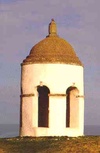
Belvedere in the form of domed arcaded rotunda. Modern harl. 6 round headed keystone arches rising from a continuous plinth. Domed roof capped by a small ball finial. Built for the Earl of Fife on a hill over-looking Duff House, the Earl's folly once housed a statue of the goddess Venus. Built by the Earls of Fife to improve the skyline. More Information |
| The 1592 Ceiling, Delgatie |

This ceiling is decorated on the beams only, mostly with a long inscription on the sides, with decorative work on the underside. |
| The 1597 Ceiling, Delgatie |

One of the most important surviving 16th century painted ceilings in Scotland The iconography has interesting comparisons to the much earlier Aberdeen Bestiary and even earlier Pictish sculpture. |
| The Carron Restaurant |
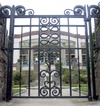
Colonel Tawse and Messrs Hall, 1936; renovated 1999-2000 by Hall and Tawse. Tall single storey and basement, 3-bay, piend-roofed, Art Deco restaurant with bowed concrete-pillared loggia/verandah and bowed front comprising Art Deco glazing to large windows combining vertical and horizontal patterning with Deco symbols, set on terrace above period garden. Banded brick and reinforced concrete. |
| The Faux Doocote, Delgatie |

The facade of a Gothic style doocote rebuilt beside the castle. More Information |
| The Mercat Cross, Banff |

Scheduled, Category A Listed,Site of Regional Significance. The cross depicts the Crucifixion on one side and on the other the Virgin and Child. The Mercat Cross originally stood where the Biggar fountain now stands, but because of it's size and it's interference with the traffic was removed in 1767 and custody given to the Earl of Fife, who erected the capital on top of a dovecote at NJ682 632. In 1900 the cross was restored within the bounds of the burgh, and in 1994 an exact replica of the 16th century cross, polychromed as it would originally have been, was placed on its 17th century shaft, and restored to almost it's original location. The original carving was placed in Banff Museum. The Reformation in Scotland was begun by John Knox in 1541, and eventually led to a widespread destruction of artworks and manuscripts by iconoclasts. The Mercat Cross survived and was given a new shaft in 1627. It is a rare survival of such overtly religious pre reformation work. More Information |
| The Milestone and Commemorative Keystone |
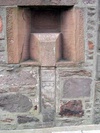
Sandstone commemorative stone worded 'THEOBALD BARCLAY 1150' 'MATHERS 1351 URIE' (see Notes below) from the 1781 bridge re-cut and set into wall below a milestone which is incised with BERVIE 10 / L(signifing Laurencekirk)14 / A(signifing Aberdeen)14. More Information |
| The Mill Inn |

Late 18th century and circa 1830, converted to flats in 1998. 2-storey and attic, 7-bay, L-plan former coaching inn converted to flatted dwellings late 20th century, with hexastyle colonnade. Red sandstone ashlar with coursed squared rubble to sides, squared and snecked rubble and some harl to rear. Cornice and blocking course. |
| The Red Well |

Red Well is a well fed by a chalybeate spring said to have healing properties. It lies within a tall circular structure with a beehive-shaped or domed roof. An iron gate forms the entrance. More Information |
| The White Bridge Stonehaven |

A highly decorative late-Victorian footbridge. Single span, shallow segmental-arched, cast-iron footbridge over Carron Water. Cast in 3 sections with dated makers plaque to centre of riveted girder, wrought-iron quatrefoil parapet, cast-iron standards with wrought-iron arch at centre, and pyramidally-coped, stop-chamfered ashlar terminal piers. |
| The Wine Tower |
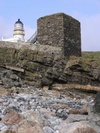
The oldest building in Fraserburgh, probably named from a past use as a wine cellar or possibly a corruption of "wynd tower". |
| Tolquhon Tomb and 17th/16th - century tombstones |

The Tolquhon Monument, built by Thomas Leper in 1589, of a chocolate- coloured sandstone, to commemorate William Forbes of |
V
| Various items at Old St.Cyrus cemetry |
|---|
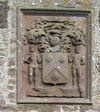
Reputed to be the site of a 13th - century kirk, there was said to be no visible signs of its position within the yard though a four-sided structure is present to the rear of the site bearing a carved stone lintel and chamfer-edged doorway. This enclosure, is said to be a burial ground. Built into a corner of the kirkyard is a small old watch-house with a good secure door and a small watch window. |
| Victoria Fountain Aberchirder |
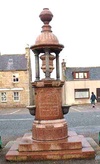
An ornate neo-classical granite fountain. More Information |
This content was submitted by external contributors and does not necessarily reflect the views of the University of Aberdeen.
